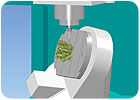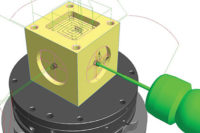
The main challenge for manufacturers today is developing the ability to produce high-quality products on a consistent basis. Both business and domestic customers are demanding better appearance and higher performance from the goods they buy. At the same time, they are increasingly likely to turn to litigation if they do not receive the quality they believe they deserve.
Of course, it is not simply enough to say that your quality is better than your competitors; you must be able to provide evidence to support the claim and that, inevitably, means increased inspection of your products.
While the need for more, and better, quality control is generally accepted, too many companies still regard inspection as an expensive, complicated and time-consuming operation that limits their profitability. Let’s see how modern inspection techniques can instead be used to make money.

The Key
For machining companies, the key to making money through inspection is to discover errors as early as possible in the process. This applies whether the company is making large, one-off items or smaller, mass-produced parts. In both cases, any delay between the problem starting and it being discovered will lead to increased costs.With the larger item, work may continue for several hours before it is discovered that the part had effectively been made scrap some time previously. Even worse, the extra machining may have turned a part that could have been saved into one that cannot be recovered.
With smaller parts, many extra faulty components may have been produced during the delay between the error arising and its being detected. This will have cost both time and money for the wasted materials.
More regular inspection causes particular problems with larger components. If an independent coordinate measuring machine (CMM) is used, considerable time is needed to transfer the parts between the machine and the inspection device and to set them up on the equipment. This can take many hours for a large, heavy part that will be difficult to align.
Furthermore, there are the time-management challenges involved in ensuring that the CMM is available when the part arrives and that alternative work is available for the machine tool while the part is being measured. Overall, it is much more effective to carry out measurements in-situ on the machine.
Repeated cycles of machining and inspection, interspersed with long set-up times on the respective pieces of equipment, are avoided, meaning that overall manufacturing times can be reduced. The added advantage is that any mistakes are discovered where they can be corrected.

A five-axis operation allows on-machine verification in fewer setups. Source: Delcam
Available Methods
Two main methods for on-machine measurement are available. The first uses a probe in the machine tool head; the second a portable inspection arm located next to the machine.Most modern machine tools either come with, or can be retrofitted with, probing capabilities to assist in the set up of the job. With an appropriate software inspection program, this same equipment can now be used for verification at little extra cost. Any interruption to the machining capacity is limited to the time taken to make the inspection as the programming can be done off-line. This approach can be used for mass production items since, once the inspection routines are generated, they can be used throughout the production run.
There can be concerns about the reliability of using a machine tool to check its own work. Of course, measurements made with a machine tool on the shop floor cannot duplicate the exceptionally high accuracy that is possible on a dedicated CMM in a climate-controlled environment. However, while that level of precision may be impressive, it is rarely needed in most manufacturing operations. In addition, the quality of the results from machine tools can be checked against known artifacts in exactly the same way that the inspection accuracy of a CMM can be confirmed.
For those that remain unconvinced, the use of a portable inspection device might be a more acceptable alternative. Typically, this will be an inspection arm for medium-sized components or an optical device for very large parts or tooling.
The main advantage of using an independent device is the flexibility as the same inspection equipment can be used on a number of machine tools, in addition to its normal inspection duties. They also make it easier to take additional measurements in any areas where the initial results give a cause for concern. However, they do require manual operation, whereas machine tool probing can be carried out automatically.
Both methods offer extra benefits for companies that operate five-axis machine tools. The probe on a five-axis machine can usually reach any areas that can be cut with the equipment, while inspection arms offer similar flexibility in accessing the whole part. For example, operators will have the ability to check undercut regions or to check a series of deep holes with different orientations, without any need to re-fixture the workpiece. Inspection on a CMM often will only be possible in three axes, meaning that extra jigs may be required to hold the part in a series of positions.
Whichever approach is chosen, taking measurements without any need to move the part can give huge cost savings by enabling the quality of the component being machined to be monitored at all stages in the manufacturing process. This allows any errors to be detected earlier and corrected more quickly and at lower cost.
For example, it is possible to check that the correct amount of stock has been left on the component after a roughing operation, rather than having to wait until all machining operations have been completed before discovering that an error has been made.
Similarly, the extent of any damage caused, for example, by tool breakage, can be assessed accurately and a decision made immediately to determine whether the part can still be completed within tolerance or whether it will have to be scrapped. It is even possible to calculate whether the part could be saved by modifying its position or by adjusting the machining toolpaths.
Of course, there are already a variety of traditional methods for undertaking such checks between machining operations. However, like all manual operations, these are time-consuming and prone to human errors and inconsistencies. Furthermore, they tend to be based on inspection against drawings, when most design data is now issued as computer-aided design (CAD) files.
The move of the checking process from the CMM room to the factory floor means that the results need to be both quick and easy to produce and understand. Since there will no longer be specialized metrologists to interpret the data produced, making the best use of on-machine verification requires software that is not only simple enough for machine tool operators to use, but that gives both quick and easy comparison of tooling or sample components against CAD data. The output must be clear, comprehensive reports that can be understood by everyone involved in the product development process, not just inspection specialists.

Using on-machine verification allows mistakes to be found where they can be corrected. Source: Delcam
Benefits
The key benefit to the company is through saving its reputation by finding mistakes before the customer does. This can be most damaging when a whole batch is rejected because of one faulty part. However, the cost of reworking a single component also can be high and will usually have to be done for no extra payment. A comprehensive inspection program will avoid both these problems by preventing defective parts from leaving the factory.Not only will this make it more likely that the customer will order from you again, but it could well lead to work from associated companies. With the current economic environment making competition even more severe, a good reputation is more valuable than ever.Q
